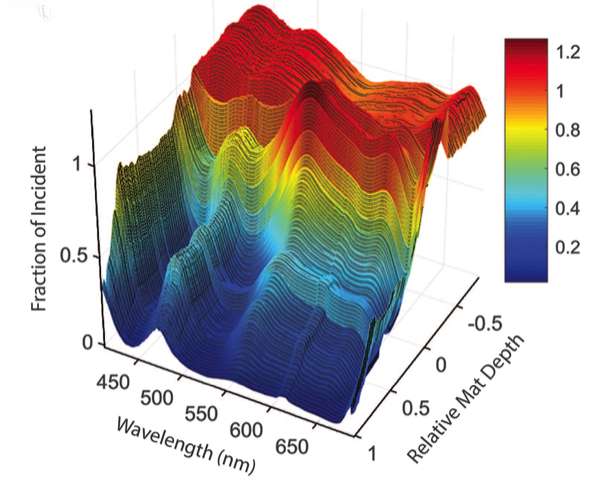Depth profile for spectral irradiance. Credit: Pacific Northwest National Laboratory
In nature's benthic microscopic realms, microbial communities gather in lattice-like mats that allow a variety of microorganisms to do the work of cooperative survival within a spatially organized environment. Photosynthetically active "primary producers" typically occupy the top of these systems, and act to convert energy from sunlight into organic matter. From there, gradients descend through gradually darkening layers inhabited by a changing variety of species.
In ecology, the Species Energy Theory postulates a positive correlation between biological energy capture and an ecosystem's species richness; that is, the most productive ecosystems have the most potential for diversity. But in microbial ecosystems, the most species-diverse on the planet, this correlation is not clear. In these tiny realms, how is diversity linked to productivity? Earlier studies, including investigations of hypersaline microbial mat systems, have profiled diversity as a function of space. But few studies have linked microbial diversity to productivity, and the relationships displayed over microbe-scale gradients remain unstudied, until now.
It turns out that spatial relationships matter in surprising ways. A new paper in ISME Journal describes a photosynthetic microbial mat, cultivated in a controlled laboratory setting and used to evaluate spatial relationships between productivity and diversity. Hans Bernstein and James Moran at Pacific Northwest National Laboratory (PNNL), along with colleagues at PNNL and Washington State University, wanted to see how vertical gradients in community composition and associated micro-environmental conditions translated to productivity. Their goal was to determine how spatial diversification of microorganisms drives localized carbon and energy acquisition rates.
Spatial gradients of productivity are inherent to microbial ecosystems dependent on sunlight for energy. After all, light is attenuated at characteristic distances related to the physical structure of the ecosystem. Benthic microbial mat systems can offer a natural testbed to explore these relationships due to inherent tight physical associations between cells and extracellular polymeric substances that strongly attenuate the light-energy that drives the ecosystem's primary productivity over short distances.
Explicit investigations of microbial diversity-productivity relationships are rarely reported. In the current study, researchers uniquely focus on spatial trade-offs between diversity and productivity. Their sub-millimeter depth profiles, intriguingly, reveal a locally inverse relationship between species diversity and productivity. Higher levels of species diversity occurs in deeper strata, which were demonstrated to have low-net primary productivity.
The experimental microcosm was derived from a benthic microbial mat native to Hot Lake in Washington State - ideal, the authors say, for studying relationships between productivity and diversity. Such mats have high bacterial diversity and pronounced gradients of chemical and physical properties within the spatial layers. Moreover, these compact microbial ecosystems exhibit a stratified biological organization created and controlled by steep photo- and geochemical gradients on sub-millimeter spatial scales.
The study's controlled incubation of a natural microbial community allows researchers to examine the spatially-resolved relation between microbial diversity and carbon acquisition using methods that are much more difficult in situ - stable isotope probing, for one.
Depth profiles of environmental properties (including dissolved O2, irradiance, and porosity) uncovered a continuum of regions corresponding to specific biological niches, which were mapped to common taxa. Productivity was assessed by two spatially-resolved, complementary metrics: the gross rate of oxygenic photosynthesis and the replacement of biomass over time, measured as a percentage of carbon. The net rate of primary productivity at similar spatial scales was derived using laser ablation isotope ratio mass spectrometry.
The results of this study contradict historical observations made at a grander ecosystem scale. But negative species-energy relationships in benthic microbial communities may be indicative of stratified, light-driven ecosystems that are most productive with relatively smaller, even distributions of species that specialize within photic zones.
The authors say their study provides new context for an underrepresented area of microbial ecology and that it illuminates little understood spatial relationships between microbial diversity and productivity at the sub-millimeter scale.
More information: Hans C Bernstein et al. Trade-offs between microbiome diversity and productivity in a stratified microbial mat, The ISME Journal (2016). DOI: 10.1038/ismej.2016.133
Journal information: ISME Journal
Provided by Pacific Northwest National Laboratory
























